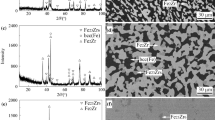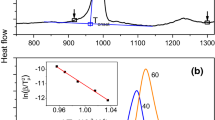Abstract
Based on ab initio calculations for Fe-Al B2 phase with and without the vacancies, the authors studied the influence of alloying by Ni, Cr, and V on the energy of vacancy formation. The authors predict that the presence of these alloying elements in the vicinity of the vacancy on the Fe site increases the energy of the vacancy formation. The present article discusses the changes of the electron charge redistribution in the vicinity of the vacancy in Fe-Al alloyed with these transition metals and link the preference of their site occupation with the peculiarities of the electron density redistribution. In addition, the authors report on the results of calculations of different types of antisite defects in Fe-Al and show that the formation of the antisite on the Al site is the energetically preferable configuration for this defect. The obtained results are in agreement with the experimental data.
Similar content being viewed by others
References
N. Junqua, J.C. Desoyer, and P. Moine, Electron Microscopy Observation of Quenching Defects in an Ordered Alloy of B2 Type: Fe-40 at% Al. Phys. Status Solidi A, Vol 18, 1973, p 387–395
D. Paris, P. Lesbats, and J. Levy, An Investigation of the Distribution of Vacancies in an Ordered Fe-Al Alloy by Field Ion Microscopy, Scr. Metall., Vol 9, 1975, p 1373–1378
K. Ho and R.A. Dodd, Point Defects in FeAl, Scr. Metall., Vol 12, 1978, p 1055–1058
C.I. Fu, Y.-Y. Ye, M.H. Yoo, and K.M. Ho, Equilibrium Point Defects in Intermetallics with B2 Structure: NiAl and FeAl, Phys. Rev. B: Solid State, Vol 48, 1993, p 6712–6715
Y.A. Chang, L.M. Pike, C.T. Liu, A.R. Bilbrey, and D.S. Stone, Correlation of the Hardness and Vacancy Concentration in FeAl, Intermetallics, Vol 1, 1993, p 107–115
P. Nagpal and I. Baker, Effect of Cooling Rate on Hardness of FeAl and NiAl. Metallurgical Transactions A, Vol 21, 1990, p 2281–2282
J.H. Schneibel and L.M. Pike, A Technique for Measuring Thermal Vacancy Concentration in Stoichiometric FeAl, Intermetallics, Vol 12, 2004, p 85–90
J.H. Schneibel, Strengthening of Iron Alu-Minides by Vacancies and/or Nickel, Mater. Sci. Eng., A, Vol 258, 1998, p 181–186
A. Fraczkiewicz, A.S. Gay, and M. Biscondi, On the Boron Effect in FeAl (B2) Intermetallic Alloys, Mater. Sci. Eng., A, Vol 258, 1998, p 108–114
C.L. Fu and J. Zou, Site Preference of Ternary Alloying Additions in FeAl and NiAl by First-Principles calculations, Acta Mater., Vol 44, 1996, p 1471–1478
I.M. Anderson, ALCHEMI Study of Site Distributions of 3D Transition Metals in B2-Ordered Iron Aluminides, Acta Mater., Vol 45, 1997, p 3897–3909
D. Wu, I. Baker, and P.R. Munroe, The Effect of Substitutional Elements on the Strain-Induced Ferremagnetism in B2-Structured Fe-Al Single Crystals, Intermetallics, Vol 12, 2004, p 851–858
M. Kogachi, T. Tanahashi, Y. Shirai, and M. Yamaguchi, Determination of Vacancy Concentration and Defect Structure in the B2 Type NiAl β-Phase Alloys, Scr. Mater., Vol 34, 1996, p 243–248
M. Kogachi, T. Haraguchi, and S.M. Kim, Point Defect Behaviour in High Temperature Region in the B2-Type Intermetallic Region Compound FeAl, Intermetallics, Vol 6, 1998, p 499–510
M. Kogachi and T. Haraguchi, Possibilities of Random Vacancy Distribution and Antisite Atom Recovering in the Point Defect Mechanism in B2-Type Intermetallics, Intermetallics, Vol 7, p 1999, 289–300
R. Krachler, H. Ipser, B. Sepiol, and G. Vogl, Diffusion Mechanism and Defect Concentrations in β′-FeAl, an Intermetallic Compound with B2 Structure, Intermetallics, Vol 3, 1995, p 83–88
R. Nakamura, K. Takasawa, Y. Yamazaki, and Y. Iijima, Single-Phase Interdiffusion in the B2 Type Intermetallic Compounds NiAl, CoAl and FeAl, Intermetallics, Vol 10, 2002, p 195–204
C.R. Kao and Y.A. Chang, On the Composition Dependencies of Self-Diffusion Coefficients in B2 Intermetallic Compounds, Intermetallics, Vol 1, 1993, p 237–250
H. Mehrer, M. Eggersmann, M. Salamon, and B. Sepiol, Diffusion in Intermetallic Phase of the Fe-Al and Fe-Si Systems, Mater. Sci. Eng., A, Vol 239–240, 1997, p 889–898
D. Fuks, A. Strutz, and A. Kiv, Bonding of Cr and V in FeAl B2 Phase, Int. J. Quantum Chem., Vol 102, 2005, p 606–611
J.P. Perdew, S. Burke, and M. Ernzerhof, Generalized Gradient Approximation Made Simple, Phys. Rev. Lett., Vol 77, 1996, p 3865–3868
P. Blaha, K. Schwarz, G. Madsen, D. Kvasnicka, and J. Luitz, WIEN2k, Institute of Materials Chemistry, Vienna University of Technology, 2001
R. Hultgren, P.D. Desai, D.T. Hawkins, M. Gleiser, and K.K. Kelley, Selected Values of the Thermodynamic Properties of Binary Alloys; American Society for Metals, 1973
C.J. Smithels, Metals Reference Book, Vol II, Butterworth, London, 1962
C.L. Fu, Origin of Ordering in B2-Type Transition-Metal Aluminides: Comparative Study of the Defect Properties of PdAl, NiAl, and FeAl, Phys. Rev. B: Condens. Matter, Vol 52, 1995, p 3151–3158
R. Kerl, J. Wolff, and Th. Hehekamp, Equilibrium Vacancy Concentration in FeAl and FeSi Investigated with an Absolute Technique, Intermetallics, Vol 7, 1999, p 301–308
M. Kass, Ch.R. Brooks, D. Falcon, and D. Basak, The Formation of Defects in Fe-Al Alloys: Electrical Resistivity and Specific Heat Measurements, Intermetallics, Vol 10, 2002, p 951–966
M. Fähnle, J. Mayer, and B. Mayer, Theory of Atomic Defects and Diffusion in Ordered Compounds, and Application to B2-FeAl, Intermetallics, Vol 7, 1998, p 315–323
G.S. Collins and L.S.J. Peng, Point Defects in FeAl, Il Nuovo Cimento, Vol 18D, 1996, p 329–337
N.I. Kulikov, A.V. Postnikov, G. Borstel, and J. Braun, Onset of Magnetism in B2 Transition-Metal Aluminides, Phys. Rev. B: Condens. Matter, Vol 59, 1999, p 6824–6833
Author information
Authors and Affiliations
Additional information
This article is a revised version of the paper printed in the Proceedings of the First International Conference on Diffusion in Solids and Liquids—DSL.-2005, Aveiro, Portugal, July 6–8, 2005, Andreas Öchsner, José Grácio and Frédéric Barlat, eds., University of Aveiro, 2005.
Rights and permissions
About this article
Cite this article
Strutz, A., Fuks, D. & Kiv, A. The influence of doping by transition metal elements on the vacancy formation energy in Fe-Al B2 phase. J Phs Eqil and Diff 26, 529–533 (2005). https://doi.org/10.1007/s11669-005-0046-z
Received:
Published:
Issue Date:
DOI: https://doi.org/10.1007/s11669-005-0046-z




